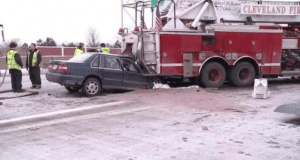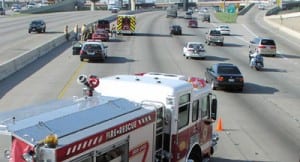 There are an untold number of incidents in which responders have been struck by vehicles while working on roadway incidents. The roadway is one of the more dangerous work environments for emergency responders to operate in because conditions can go from being totally benign to total chaos in just a matter of seconds.
There are an untold number of incidents in which responders have been struck by vehicles while working on roadway incidents. The roadway is one of the more dangerous work environments for emergency responders to operate in because conditions can go from being totally benign to total chaos in just a matter of seconds.
The Roadway Mindset
When operating on the roadway, our minds should always be on the drivers who, for one reason or another, don’t seem to see us, or are motivated to get through the accident scene because they can’t be inconvenienced with a delay. There are multiple plausible explanations as to why drivers hit emergency vehicles and first responders, including:
- General inattentiveness
- Visual impairment
- Ill or infirmed
- Distracted
- Texting
- Talking on a cell phone
- Performing other activities while driving
- Impairment (drugs or alcohol)
- Fatigue
- Ice
- Hydroplane
- Gawking
- Blinded by bright lights
Take a long look at that list. There are so many factors that could contribute to a motorist endangering a responder that we should always be on high alert.
Protecting Your Operating Position
 The best thing a crew can do is put themselves in a defensive position by using vehicles to block the roadway. This may not be a popular solution if a police officers has an ambition to keep traffic flowing. In their defense, keeping traffic flowing may improve safety and reduce the likelihood of a secondary incident upstream. However, the safety of responders should never take secondary priority to keeping traffic flowing.
The best thing a crew can do is put themselves in a defensive position by using vehicles to block the roadway. This may not be a popular solution if a police officers has an ambition to keep traffic flowing. In their defense, keeping traffic flowing may improve safety and reduce the likelihood of a secondary incident upstream. However, the safety of responders should never take secondary priority to keeping traffic flowing.
Blocking May Not be Enough
Even when a large apparatus with active warning lights are blocking a scene, civilian vehicles can still strike the apparatus and endanger responders. It is important to keep in mind that until traffic has been stopped upstream, responders are vulnerable.
The highest and often most complex part of situational awareness development is being able to predict the future. When you look at the list of potential contributing factors above, the potential for a highway incident becomes highly probable. Be mindful and vigilant when you are on the roadway. At any given time there are drivers… many drivers… affected by the list of contributors that result in responder-victim roadway accidents.
About the Author
Richard B. Gasaway, PhD, CSP is widely considered a trusted authority on human factors, situational awareness and the high-risk decision making processes used in high-stress, high consequence work environments. He served 33 years on the front lines as a firefighter, EMT-Paramedic, company officer, training officer, fire chief and emergency incident commander. His doctoral research included the study of cognitive neuroscience to understand how human factors flaw situational awareness and impact high-risk decision making.
_____________________________________________________

If you are interested in taking your understanding of situational awareness and high-risk decision making to a higher level, check out the Situational Awareness Matters Online Academy.
CLICK HERE for details, enrollment options and pricing.
__________________________________
Share your comments on this article in the “Leave a Reply” box below. If you want to send me incident pictures, videos or have an idea you’d like me to research and write about, contact me. I really enjoy getting feedback and supportive messages from fellow first responders. It gives me the energy to work harder for you.
Let’s Get connected
Facebook: SAMatters
LinkedIn: Rich Gasaway
LinkedIn: Situational Awareness Matters
Twitter: Rich Gasaway
Youtube: SAMattersTV
itunes: SAMatters Radio
Stitcher Radio: SAMatters Radio
Google Play: SAMatters Radio
iHeart Radio: SAMatters Radio

We call them “D” drivers – distracted, drunk, drowsy, disturbed, disrespectful, disgruntled, and just plain dangerous. Many of the strategies used for defense today are visual and require drivers to look out the windshield to see what’s ahead. Sadly, many drivers aren’t looking out the windshield today and they fail to see signs, cones, flares, warning lights, chevrons, hi-viz PPE and even fire apparatus blocking at incident scenes. Digital alerting technology will help over time but we need ways to influence and change driver behavior now, starting with how new drivers learn to drive. Watching the bad driving habits displayed by Mom & Dad are not helping. Lack of enforcement for driving laws (I.e. move over, speeding, etc.) doesn’t help either. How do we influence and improve situational awareness for today’s “D” driver?
The best offense is a good defense. You’re probably not going to like my answer. I think changing the behaviors of drivers will prove to be an impossible task. So, the best we can do is to change the tactics applied by responders to anticipate and protect themselves against the “D” drivers.
An effort to change the behaviors of millions of motorists is tantamount to trying to change how the sun shines on the earth to prevent sunburns and skin cancer.
My humble opinion is to focus on improving the situational awareness of responders to protect themselves against the “D” drivers. I know you’re trying and you’re probably frustrated with how many responders STILL don’t follow your outstanding best practices. If you think that is frustrating, multiply it by a factor of millions as you try to improve the situational awareness of the “D” drivers.
Someone once told me: “Don’t try to teach a pig to sing. You’ll never be successful and you’ll only annoy the pig.” The corollary: Don’t try to teach drivers of to be more aware than they want to be. You’ll never be successful and you’ll only annoy the drivers.
Whenever the Responder Safety Institute might feel ready to look at things in a different way, there are MANY situational awareness lessons that could be incorporated into your curriculum. But, alas, up to this point, no one has asked me. 🙁